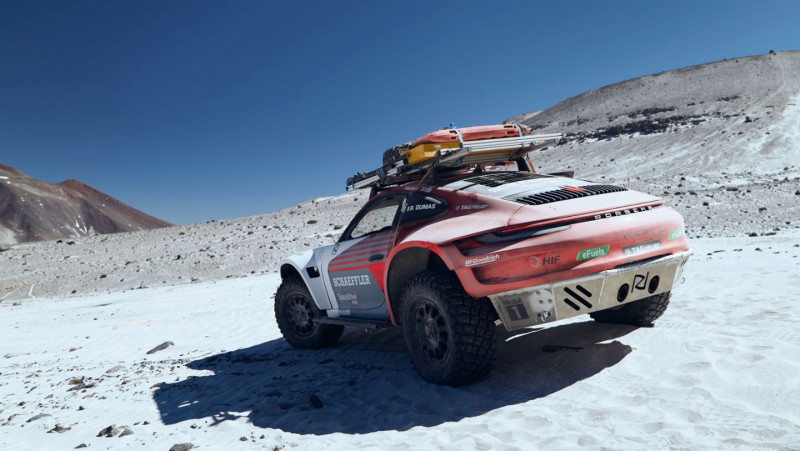Modified 2024 Porsche 911 Carrera 4S 992 sets new altitude world record in Chile
6,734 metres above sea level. No car has ever gone higher. On 2nd December, former Porsche works driver and Glickenhaus WEC contender, Romain Dumas, set a new world record at the peak of Ojos del Salado volcano’s west ridge, piloting a significantly modified 911 (running on eFuel) up the Chilean summit. He was supported by an international team (consisting of members from Chile, France, Germany, the United States, Canada and Switzerland) facing extreme conditions — the air at altitude was only half as dense as at sea level, while temperatures hovered around twenty degrees below freezing.
“I’ll never forget this experience. It was an extraordinary feeling to drive where no car has gone before,” says Dumas, a three-time winner of the 24 Hours of Le Mans. “The 911 managed to go higher than any other earthbound vehicle in history. We reached the true summit of the west ridge. We literally couldn’t get any higher. We consider this the maximum altitude achievable in a motor car,” he smiles.

Two modified examples of the current 992 Carrera 4S were used for the challenge. The cars, nicknamed Doris and Edith, were developed by RD Limited (Dumas’ personally owned team) in collaboration with Porsche. The record itself was achieved by Dumas in Edith, the lighter and more agile of the cars. The conversion utilises the standard near 440bhp three-litre flat-six and seven-speed manual gearbox, which benefit from advanced Mobil 1 lubricants enabling the powertrain to operate without issue in the extremely cold climate.
On account of its robust yet lightweight chassis construction, ample power and the ability to cope well with extremely high altitudes, the 911 proved to be an excellent choice for the challenge.
The two cars were equipped with carbon-fibre seats and five-point harnesses. Portal axles (where the axle tube or driveshaft is offset from the centre of the wheel hub and where driving power is transferred to the wheels via a simple gearbox built onto each hub) were added to increase ground clearance to 350mm. These parts also have the effect of reducing gear ratios, allowing for precise, gentle throttle input at low speed. In addition, the cars were equipped with special lightweight (but extremely tough) Aramid-fibre underbody protection panels to allow for sliding over rocks.
The lead car was equipped with a special additional piece of technology: steer by wire, developed and provided by Schaeffler Group.
The system (marketed as Space Drive and enabling steering of the host vehicle without a steering column connected to the wheel axles) was capable of meeting the unique and extreme demands of the volcano’s terrain, offering precision and detailed feedback, thereby allowing Dumas to place the Porsche precisely where he needed it, often while ascending precarious and near-vertical slopes. The team took two weeks to acclimatise to the changing altitude, gaining height day after day. The cars had no such difficulties — the 992’s standard systems sensed the thinner air and adjusted fuelling accordingly, meaning performance was maximised at all times.
THE CONVERSION UTILISES THE STANDARD NEAR 440BHP FLAT-SIX AND SEVEN-SPEED GEARBOX


